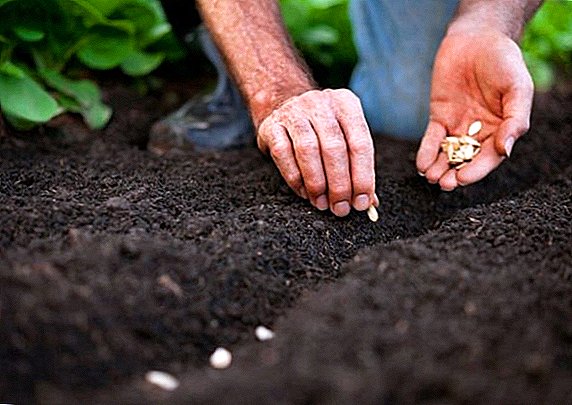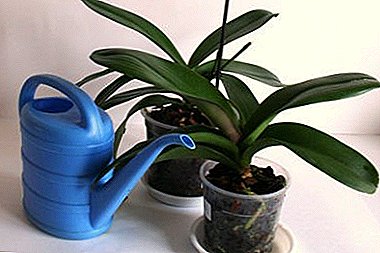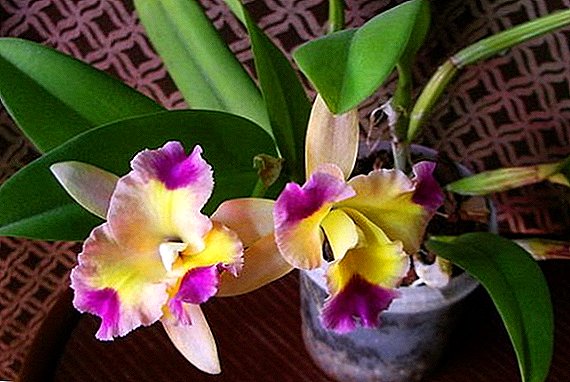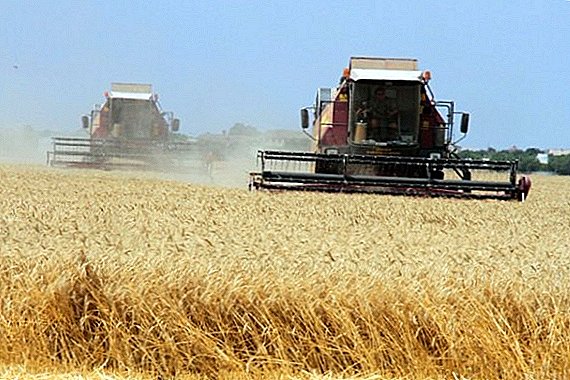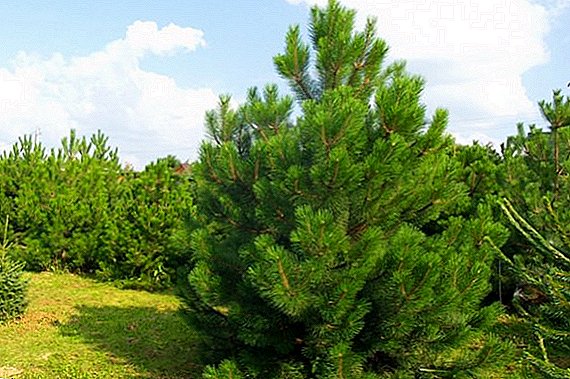 In urban conditions, black pine is a very promising breed, characterized by good decorative properties, proper planting and care for it will allow to grow a perennial beautiful plants.
In urban conditions, black pine is a very promising breed, characterized by good decorative properties, proper planting and care for it will allow to grow a perennial beautiful plants.
Thick needles and dark color of the trunk creates a unique dark stands. The breed grows on most types of soil, has a wide range of decorative forms.
In this article you will learn what the main varieties of black pine are used for decorative purposes, its description of how to grow seedlings and care for plants.
Black pine: description and varieties
Black pine (known in Latin as Pinus nigra) is a wild plant found in the mountains of Europe. It mainly grows on high slopes at a height of one and a half thousand meters above sea level, on calcareous soils of southern slopes.
In the wild, it grows mainly in the mountains, so many gardeners know it as a black mountain pine. The tree reaches a height of 40 m, have a straight trunk with deeply striated black and gray bark. In young trees, the crown is pyramid, from old representatives it takes the form of an umbrella-like.  The needles have two needles in a bundle, dark green color, solid, needle-shaped, straight or slightly curved with a sharp tip. Cones on the branches grow horizontally, yellow-brown in color, with a short petiole.
The needles have two needles in a bundle, dark green color, solid, needle-shaped, straight or slightly curved with a sharp tip. Cones on the branches grow horizontally, yellow-brown in color, with a short petiole.
Different varieties of this type of pine can be selected for wind protection, for group or soliternoy planting, as a decoration for a garden, alpine slide or pond. There are even subspecies that are used for bonsai.
The best flowers for the alpine slide are: alissum, crocuses, young, iberis, bells, fescue.
Globosa variety has a beautiful, dense, round crown, it is about 3 m high, crown diameter is 3-4 m. Nana looks no less delightful and the unique Spilberg, which forms a ball up to 2 m in diameter.  The narrow columnar crown is distinguished by the Pyramidalis variety, the tree Fastigiata is more compact. Up to 5 m grow very popular cultivars Sinfonia and Green Rocket.
The narrow columnar crown is distinguished by the Pyramidalis variety, the tree Fastigiata is more compact. Up to 5 m grow very popular cultivars Sinfonia and Green Rocket.
Gardeners prefer a variety that grafts on a low trunk and forms a ball, namely Brepo.
If you want to get a compact pillow or a ball in the garden, use these varieties: Marie Bregeon, Rumamaa, Ottos Compacta, Jeddeloh - they successfully grow in a Japanese garden, as well as rock gardens and a common flower bed with bright colors. 
The best place to land
Pines are winter-hardy trees, they carry dry air well. Also conifers are resistant to environmental pollution.
Shadow or light?
Pine is a very light-loving plant. It grows well in constantly lit areas. It is recommended to plant black pine seedlings in open sunny places.
Soil requirements
For pine suitable sandy or sandy soil. If there is heavy soil on the site (clay and loam), additional drainage will be needed. For drainage suitable sand, expanded clay, fragments of broken bricks. It is recommended to make a drainage layer with a thickness of at least 20 cm in the landing pit.
Still need to pay attention to the acidity of the soil. For black pine soil should be alkaline or neutral. If the soil is too acidic, this can be corrected with lime.
0.3 kg of lime is added to the planting pit and mixed with the soil. After that, water is poured into the pit, and only then a sapling is planted. 
Planting rules seedlings
Pine black, which is called nigra pine because of the color of the trunk, is a very cold-resistant plant, tolerates high and low air humidity quite well. Almost all types are undemanding to the composition of the atmosphere and grow even in environmentally hazardous conditions.
Did you know? An ancient Greek legend says that pines descended from the nymph of the morning dawn - Pitis, in order to hide from Boreas, the god of the north wind, she turned into a pine tree.
Before planting, you should choose only high-quality seedlings that can be purchased in a specialized varietal nursery. You can also try to take a sapling from the nearest pine planting, but such plants grow slowly, get sick and often do not take root in principle.
Wild saplings die mostly in a few years. Seedlings should not be younger than three years and not older than five years. Together with the container, carefully seedling should be transported to the landing site.
Having bought a sapling in a nursery, you get a guarantee of its normal growth, and also get valuable information about planting and caring for a tree.  Gardeners recommend planting a plant in spring and autumn, but in practice the ideal time for planting seedlings is the middle of spring, the end of April is best.
Gardeners recommend planting a plant in spring and autumn, but in practice the ideal time for planting seedlings is the middle of spring, the end of April is best.
A mountain pine sapling is planted without removing the earthy coma that has been preserved from the nursery. Carefully place the seedling in the pit, fill the free space with soil, controlling the vertical position of the tree.
Tamp down the soil gradually, start at the outer perimeter of the pit and after the seedling has sat down a bit - start tamping the entire plane.
Important! The root neck when planting must necessarily be on the surface - above the level of the soil, otherwise the seedling may disappear.

Pit preparation
Before planting this tree should be properly prepared pit.
The size of the pit depends on the size of the root system of your seedlings. Along the perimeter of the pit, the reserve should be 20 cm, in depth - not less than 30 cm, the arrangement of the drainage layer enters this depth.
Soil should not be heavy, it is best to take cooked. To prepare the right soil, mix turf soil, clay and river sand in the following proportion: 2 parts of soil, 2 parts of clay, 1 part of sand, add also about 40 g of nitrogenous fertilizers.
Pour a layer of drainage to the bottom of the pit, prepare the ground from above and tamp it slightly. Based on the size of the root system of the seedling, it is necessary to make a hollow and moisten the soil.
Landing pattern
The landing pattern should be as follows. It is necessary to take into account the size, if you are planting adult plants and accordingly make the necessary intervals. If you plant small saplings of small varieties - leave a distance of one and a half meters between the trees, if the pine variety is larger, you should leave about five meters between the trees.
Care rules
Caring for black pine is quite simple, since this plant is not demanding. Let's take a closer look at what you need to pay attention to when caring for pine.
Watering and soil care
This plant does not need additional watering. Black pine is a drought-resistant tree. And it should be watered only during very dry periods.
Important! It should be remembered that the pines do not tolerate moisture and stagnant water.
Also retaining the needles contributes to the retention of moisture in the soil. Additional watering is possible in the autumn period (all the leaves will fall off). Such watering is recommended to new seedlings, as wet soil freezes through less, and this protects the seedling from spring needles burning.
Pine needles burn for the reason that the pine crown wakes up early enough, and the frozen soil does not give the roots enough moisture. This is offset by additional watering in the fall.  Still need to pay attention to the soil around the plant. If the soil is compacted, then it must be loosened.
Still need to pay attention to the soil around the plant. If the soil is compacted, then it must be loosened.
A conifer bed will form around the tree. Do not remove it, as it will retain moisture and form humus.
Top dressing
It is recommended to feed young saplings the first couple of years after planting. It is better to feed seedlings with liquid fertilizers so that the fertilizer gets into the soil faster and further into the plant.
For adult trees, solid organic fertilizer in the form of pellets or powder can be used as a top dressing.
Did you know? Artificial silk and artificial leather are made of pine wood.For normal development, the plant will have enough organic fertilizer that will accumulate in the litter under the tree.
Pruning
Regular pruning of trees is not necessary.
If desired, you can form the crown of black pine, make it more lush. To do this, in the autumn they spend pruning annual growths.
You can also cut pine to slow growth. For this you need to cut the young twigs about a third of the length. 
Frost protection
Adult pine Stoics to frost. And for young seedlings need care, as they can get sunburn. Therefore, in the winter they are covered with spruce leaves, rare sacking or special covers.
Important! It is strictly forbidden to cover young pines with thick material and polyethylene. This material vyperevaet seedlings.Crowns of young trees are recommended to be sheltered at the end of autumn and to leave shelter until mid-August.
How black pine breeds
Gardeners most often receive seedlings when a tree propagates with seeds, since propagation by cuttings and grafting is not as effective. If you want to go all the way when planting from beginning to end, try to grow a seedling from seed.
Plant seeds in open ground or special boxes. Planting in boxes is preferable, since the seeds in the open ground can destroy rodents.  Pine seeds do not need additional stratification, although you can still accelerate the growth of seedlings if you use a change in the surrounding temperature.
Pine seeds do not need additional stratification, although you can still accelerate the growth of seedlings if you use a change in the surrounding temperature.
With a sharp warming the seeds germinate faster. To arrange a sharp contrast in temperature, put the seeds in the freezer, and then place them under warm water.
The boxes in which the seeds will grow can be from any material, make holes in them to drain excess moisture. In the crate, the ground should be loose, and also sprinkle it with peat on top.
Peat is needed for the prevention of fungal diseases, young seedlings are very susceptible to them. 
Sow the seeds shallowly, you can simply pour them on the prepared soil, then loosen it. The distance between the seeds should be 5 mm at least, if you do not observe such a distance, the seedlings will lift the ground and tender roots can dry out.
Plant Diseases and Pests
For mountain pine, such diseases are terrible: rust, rust cancer (resin cancer, seryanka), pine pinwheel, scleroderriosis (umbrella disease), necrosis of the bark, schutte.
Careful care of plants will allow to protect your seedlings from pests, which in this class a lot, namely, Hermes, bug pine podkorny, pine scale insects, aphids, pine, pine Jose scale, pine sawfly, spider mites, pine moth, pine looper, rhyacionia pines, pine scoop, cone fire, pine miner moth, resin cone, pine barbel, pine zlatka, large and small pine bark beetle, Smolevka dot, pine elephant.  Recently, pine has become not only a New Year tree, but also a very popular plant among gardeners, especially in suburban areas, where people enjoy its beauty and aroma. Planting a black pine will not be difficult, and it will delight you for many years.
Recently, pine has become not only a New Year tree, but also a very popular plant among gardeners, especially in suburban areas, where people enjoy its beauty and aroma. Planting a black pine will not be difficult, and it will delight you for many years.



